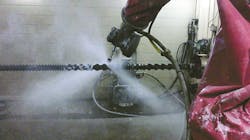Special Report: NLB eyes extruders for cleaning system
NLB, a manufacturer of high-pressure water jetting equipment, is offering a cleaning system for extrusion companies.
NLB primarily sells water-jet cleaning equipment to industrial customers and cleaning contractors. More than 20 years ago, a company involved in extrusion asked NLB to help it find a solution for more quickly and thoroughly cleaning plasticizing screws and other tooling. Recently, NLB has begun marketing the technology to others in the industry.
"Many screws are cleaned manually or are burned clean," said Jim Van Dam, NLB director of product development and marketing. "Both of these methods are very time consuming and can require a lot of man-hours to complete. Even then, many times the results are not what operators would like to see. A water-jet screw-cleaning cabinet can clean a screw in under 10 minutes."
Van Dam described NLB's washing systems as "pressure washing on steroids."
"The systems we provide are typically 20,000 psi at about 15 gallons per minute," he said. "You're talking about a pressure washer that is being driven by a 150-horsepower electric motor."
Van Dam said NLB's initial extrusion customer recently came back seeking a new jet-washing cabinet.
"The first one that we did, the company has come back to us and asked us to redesign it and to rebuild it in a little different configuration," Van Dam said. "So, we're redesigning that system for them, and at the same time we're starting to market it to other companies."
The system NLB is building is programmable to accommodate diverse screws. The jet spray head moves inside the cabinet, and the motion and angle vary depending on the screw.
"They pick the screw and the machine runs," Van Dam said. "Ten minutes later, you have a clean screw. That's not an exaggeration. That's what catches them. They look at you like they don't believe it is possible, but it is. It is much, much faster."
Cleaning an extrusion screw using manual methods could easily take a day, Van Dam said.
However, an extrusion company must be cleaning screws frequently for this solution to make economic sense.
"It's not an inexpensive solution," Van Dam said. "You have to be doing the process enough, and it has to be enough of a burden that they would take on a process like this. It seems the people this is of interest to are the people doing compounding, because they are doing different runs of material and they don't want cross contamination."
Using water jets to clean the screw removes the risks of someone nicking or otherwise damaging the screw, Van Dam said. He added the company has yet to find a material its system could not remove.
Bruce Geiselman, senior staff reporter
NLB Corp.,Wixom, Mich., 248-624-5555, www.nlbcorp.com
About the Author
Bruce Geiselman
Senior Staff Reporter Bruce Geiselman covers extrusion, blow molding, additive manufacturing, automation and end markets including automotive and packaging. He also writes features, including In Other Words and Problem Solved, for Plastics Machinery & Manufacturing, Plastics Recycling and The Journal of Blow Molding. He has extensive experience in daily and magazine journalism.

